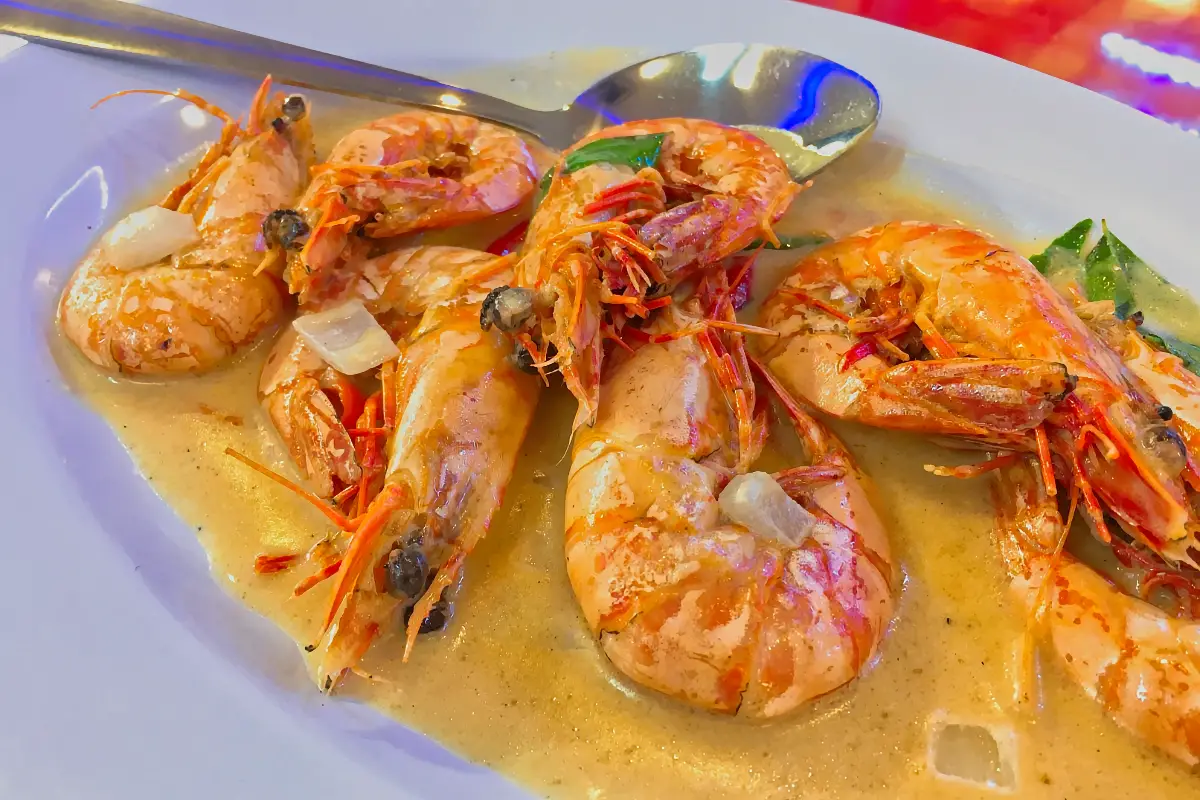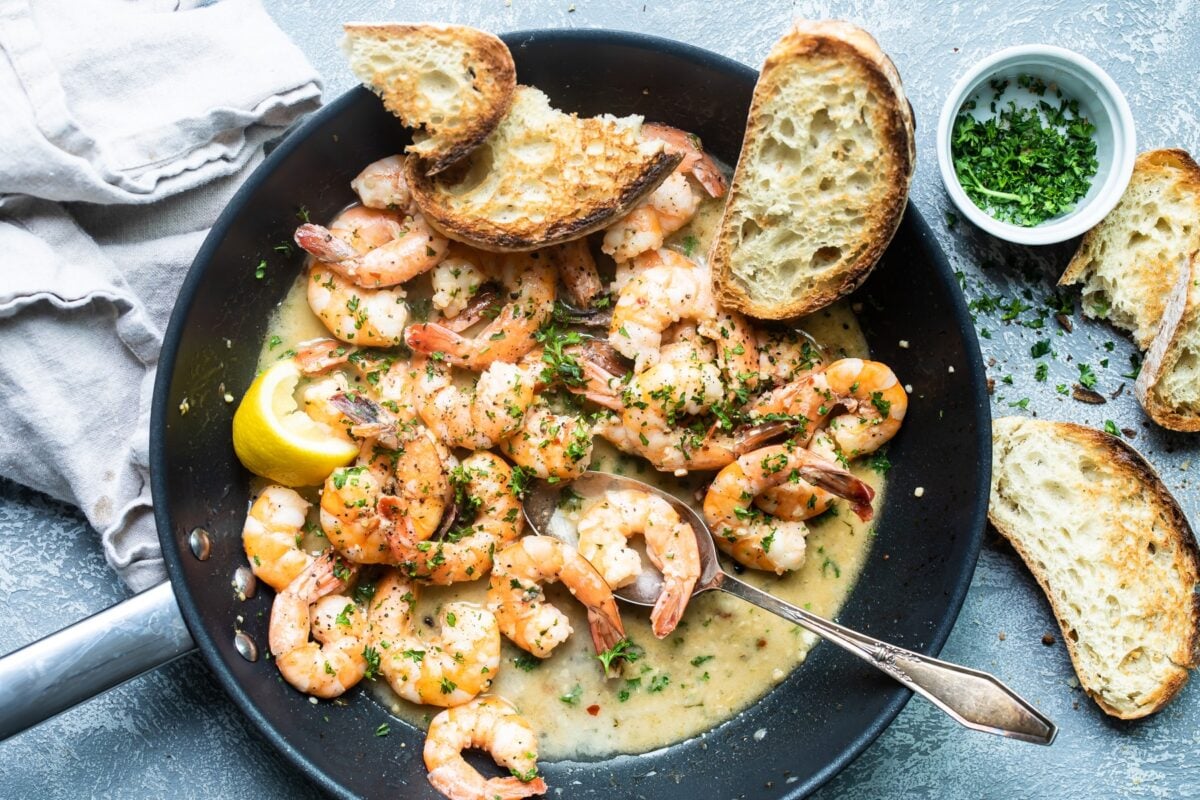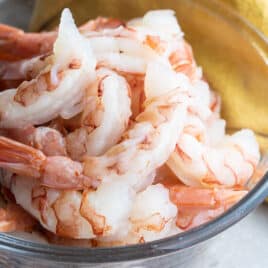Learn How to Clean Shrimp just like caterers and culinary professionals everywhere. This quick and easy guide will show you how to clean and devein shrimp so that your best recipes always have beautiful, juicy shrimp.
Technically, it is not necessary to clean shrimp. The black line on the shrimp’s bottom, which is also known as a “vein,” is its digestive tract. The shrimp may be darker than the rest of the meat because of sand, algae, or other grit that came from what it ate before it was caught.
Some people find it gross or are turned off by the word “shrimp poop,” but it’s not really bad to eat. However, shrimp just look better without it.
On the other hand, peeling shrimp before eating them makes for a better experience texture-wise. But even that isn’t absolutely necessary. On the East Coast, seafood markets sell spiced, boiled shrimp that is still on the peel. A lot of people love it. In culinary school, I ate shrimp in the shell, and the worst thing was that my jaw hurt after a while.
You can get better shrimp for less money and a wider range of sizes if you can clean and shell our own prawns and shrimp. In my book, that’s one of the best reasons to do it yourself.
Argentine red shrimp are a delicious type of wild-caught cold water shrimp known for their sweet, lobster-like flavor and bright reddish-pink shells Their tender texture and sweet taste make them an appealing choice for seafood lovers. However, before cooking these tasty shrimp, it’s important to know how to properly clean them.
In this article I’ll provide a step-by-step guide to cleaning Argentine red shrimp including removing the shell, deveining, and rinsing. With just a bit of practice, you’ll be able to prep these shrimp for cooking in no time!
Argentine red shrimp (Pleoticus muelleri) are a species of shrimp found in the chilly waters off the coast of Argentina. They live at depths of up to 600 feet, which gives their meat a firmer texture compared to warm water shrimp. Their natural habitat also lends a delicate, sweet flavor.
These wild-caught shrimp are highly sought after for their impressive size, bright reddish-orange shells, and exquisite taste. The largest can reach lengths of over 5 inches! Due to their premium quality, Argentine red shrimp can be pricier than other shrimp varieties. However, many seafood aficionados find their sweet taste and tender meat worth the splurge.
Step 1: Rinse the Shrimp
You should rinse the shrimp under cold running water before you start to clean them. This helps get rid of any sand, dirt, or other things stuck on the shell or body. Place the shrimp in a colander and run cold water over them for 30 seconds to one minute.
Step 2: Remove the Shell
Argentine red shrimp have a hard, segmented outer shell that needs to be removed before cooking. Start by pulling off the head and legs, then peel away the shell from head to tail. You can leave the last segment near the tail intact for presentation if desired.
Some cooks prefer to leave the shell on for grilling or boiling to impart more flavor. If leaving shells on, use kitchen shears to cut along the back to expose the vein.
Step 3: Devein the Shrimp
Next, devein the shrimp by cutting out the digestive tract or the vein that runs along the back of the shrimp. There are a few methods you can use:
-
Slit method: Cut a small slit down the back of the shrimp with a paring knife. Grab the tip of the vein and gently pull to remove it. Rinse under water afterwards.
-
Skewer method: Insert a thin skewer into the vein canal and wiggle it to loosen the vein. Slowly pull the skewer to extract it.
-
Butterfly method: Make shallow cuts along both sides of the shrimp back and open it up like a book to expose the vein. Scrape it out with your fingers or knife tip.
No matter which deveining technique you use, be sure to thoroughly rinse the shrimp afterwards to remove any debris.
Step 4: Rinse Again
Give the peeled, deveined shrimp another good rinse under cold water to remove any shell fragments or remnants of the vein. Drain excess water before cooking or storing.
Extra Cleaning Tips
-
Use a soft brush to scrub the shrimp under running water if needed to dislodge dirt or other grime.
-
Trim off the pointy “nose” or rostrum at the head end for aesthetic purposes.
-
For a more thorough cleaning, soak the shrimp in salted water for 5-10 minutes to draw out impurities, then rinse again.
Storing Cleaned Shrimp
Freshly cleaned shrimp can be stored covered in the refrigerator for 1-2 days before cooking. Place them in a bowl lined with paper towels to absorb excess moisture.
For longer storage, freeze peeled, deveined shrimp in an airtight container or bag. Frozen shrimp will keep for 2-3 months.
Thawing Frozen Shrimp
To thaw frozen Argentine red shrimp:
-
Place sealed bag of shrimp in a bowl of cold water. Change water every 30 minutes. Thaw time is about 1 hour.
-
Thaw overnight in the refrigerator. This slower method helps maintain quality.
-
Defrost in the microwave using the defrost setting. Check often to avoid cooking.
Avoid thawing shrimp at room temperature or in hot water, as this encourages bacteria growth.
Cooking Your Fresh Argentine Red Shrimp
The sweet taste and delicate texture of Argentine red shrimp shine through with quick, simple cooking methods like sautéing, broiling, or grilling. Just 2-3 minutes over high heat is sufficient. Take care not to overcook them.
Here are some serving ideas to enjoy their sweet, lobster-like flavor:
-
Sauté in olive oil with garlic, lemon, and parsley
-
Make shrimp cocktail or ceviche
-
Grill with lime juice and cilantro
-
Bake en papillote (in parchment paper) with veggies
-
Add to pasta, risotto, salad, or tacos
With this step-by-step guide, you can easily prep Argentine red shrimp for your favorite recipes. Just rinse, peel, devein, and they’re ready to cook and enjoy! Proper cleaning brings out their naturally sweet ocean flavor.

Tutorial tips and variations
- Sizes of shrimp: Shrimp are sorted by size and given a number both on the boat and in the factory. This number tells you how many shrimp are in a pound. The number 16/20, for instance, means that there are sixteen to twenty shrimp in a pound. Sometimes you’ll see the letter U before a number, like U10. In other words, there are about 10 shrimp or less per pound.
- The higher the number, the smaller the shrimp. The lower the number, the larger (and pricier) the shrimp. Don’t be afraid to go small. You can make shrimp salad, stir-fry, or a big batch of fried rice with tiny shrimp. For big events, save the biggest shrimp for things like super fancy shrimp cocktail or shrimp skewers. For extra colossal shrimp, U10 shrimp means less than 10 shrimp per pound. For colossal shrimp, U15 shrimp means less than 15 shrimp per pound. For extra jumbo shrimp, 16/20 shrimp means 16 to 20 shrimp per pound. For extra large shrimp, 26/30 shrimp means 26 to 30 shrimp per pound.
- Fresh vs. Unless you live right on the water, frozen shrimp is the best option. Most of the shrimp that comes to our store has already been frozen, usually as soon as it’s caught on the boat. That’s why I always buy frozen shrimp. Getting the freshest shrimp possible means letting them thaw at home. Someone else thawed the shrimp before you bought it at the store, but you don’t know when. Might as well just buy frozen.
- How to Buy Shrimp: Have fun while you’re shopping for shrimp. Fresh shrimp that is of good quality should smell salty and even sweet, like the ocean. A sign of old shrimp is black spots on the shells that smell like ammonia and are slimy. If the shrimp have these traits, you should go somewhere else.
- How to store shrimp: Put fresh or thawed shrimp in the bottom drawer of your fridge so that any leaks don’t get on other food in the fridge. Use fresh or thawed shrimp with 1 to 2 days.
- Wild vs. farmed shrimp: That depends on your and your grocery budget. Wild-caught shrimp taste better, but they can cost a lot more. If you can find it, farm-raised shrimp from a responsible grower is a good choice. If you’re not sure, read the label carefully. Shrimp farmers are proud of their efforts to be environmentally friendly and will put that information on the label. Learn all the latest news at SeafoodWatch. org.
- Stock of shrimp: Freeze those shells and make a tasty batch of Homemade Shrimp Stock. For this recipe, you’ll need 4 cups of shrimp shells from 2 pounds of shrimp. You can gather it in batches, though. Until you have enough, put raw shrimp shells in a plastic bag and freeze them. You can technically use cooked shells to make stock, but the flavor will be less strong. Using shrimp stock in seafood sauce in the future will make sure that it has a strong ocean flavor.

Technically, no. The shrimp has a small black line on its bottom that is called a “vein.” It is just a digestive tract. The meat could be darker than the rest of the shrimp because of what it ate before it was caught. It could also have sand or algae in it. It could have some sand in it, or algae. Some people find it gross or are turned off by the word “shrimp poop,” but it’s not really bad to eat. It just looks better without it.
It’s better for your taste and texture to peel shrimp before eating them, but it’s not always necessary depending on the dish. On the East Coast, seafood markets sell spiced, boiled shrimp that is still on the peel. A lot of people love it.

Wild Argentine Red Shrimp Peeling process
FAQ
Do you have to devein Argentine shrimp?
Can you eat Argentinian red shrimp heads?
How to cook Argentine red shrimp?
To cook Argentine Red Shrimp, first prepare them. Then, explore these versatile cooking methods: Grilling: Fire up the grill and bring out the smoky flavors. Marinate the shrimp with your favorite seasonings, skewer them, and grill for 2-3 minutes per side until they turn opaque and slightly charred.
How do you clean Argentine red shrimp?
Cleaning Argentine red shrimp with shell on is essential to remove any impurities and ensure a delicious taste. Start by rinsing the shrimp under cold water to remove any dirt or sand. Then, carefully peel back the shell, leaving the tail intact.
Can you eat the shell of Argentine red shrimp?
Yes, you can eat the shell of Argentine red shrimp if it is cooked properly. The shell becomes crispy and adds a delicious texture to the shrimp. However, some people prefer to remove the shell before eating for convenience. It is a matter of personal preference, so feel free to enjoy the shrimp with or without the shell.
How do you thaw Argentine red shrimp?
To thaw Argentine Red Shrimp, place them in the refrigerator overnight. Alternatively, you can thaw them quickly by placing them in a sealed plastic bag and immersing them in cold water. After thawing, rinse the shrimp under cold water and pat them dry with a paper towel.
